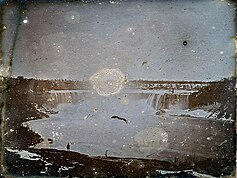Hugh Lee Pattinson
Hugh Lee Pattinson | |
|---|---|
Alston, Cumberland | |
| Died | 11 November 1858 (aged 61) |
| Resting place | Washington, County Durham |
| Nationality | English |
| Alma mater | Self-taught |
| Known for | Silver refining process, daguerreotypes |
| Spouse | Phoebe Walton |
| Scientific career | |
| Fields | Metallurgy, Industrial chemistry |
Hugh Lee Pattinson FRS (25 December 1796 – 11 November 1858) was an English industrial chemist. He was also an entrepreneur, sharing the risk of major industrial developments with famous ironmaster
Although known in his time for his 1833 patent "An improved method for separating silver from lead", a process that bears his name, he is best remembered today for his daguerreotype photographs taken in 1840. Among these is the earliest known photograph of the Niagara Falls.
Biography

Pattinson was the son of Thomas Pattinson, a shopkeeper in the country town of
He began his working life by helping his father in his shop in Alston. In around 1825 he worked for Anthony Clapham, a soap maker in
In 1834 he resigned from Beaumont's works, and with John Lee and George Burnett, set up a new chemical works at Felling, near Gateshead.[3] It employed around 300 men.[4]
Pattinson process
Pattinson patented his
The patent process, known as pattinsonisation, earned Pattinson £16,000 in royalties. The earlier process of "cupellation" had required at least 8 ounces (230 grams) of silver per ton of lead to be economic. Cupellation involved removing the lead from a silver-rich alloy by oxidising the lead to litharge, leaving the silver behind.[7] Pattinson's process was economic with as little as 2 to 3 ounces (about 75 grams) of silver per ton.[3]
Daguerreotypes

In about 1840, Pattinson travelled to Canada in the hope of setting up a mining business,
Other inventions
In 1841 Pattinson patented two other chemical processes, one for making lead carbonate,[12] and the other for manufacturing "magnesia alba", a white magnesium oxide.[3] In 1849 he patented his process for making a new white lead pigment, lead oxychloride.[12]
His lead oxychloride process became a profitable industrial reality in 1850, when Pattinson and his partners (and sons-in-law)
Honours and achievements
In 1838 Pattinson became vice-president of the chemical section of the
Pattinson was made a
Family life
Pattinson married Phoebe Walton on 25 December 1815, having been baptised by the vicar of Alston, Benjamin Jackson, as a member of the
Pattinson's three daughters married, respectively, the ironmaster
He died on 11 November 1858. He was buried in
References
- ^ a b "Hugh Lee Pattinson". Newcastle upon Tyne: Newcastle University. 2010. Archived from the original on 15 April 2010. Retrieved 29 November 2012.
- ^ a b Lonsdale, 1873. pp273-287.
- ^ a b c d e f g h Oxford Dictionary of National Biography, 2012.
- ^ "Ten interesting facts about Felling". Newcastle Evening Chronicle. 1 January 2012. Archived from the original on 2 February 2013. (retrieved 30 November 2012)
- JSTOR 41334470– via JSTOR.
- ^ Tylecote, R. F. (1992). A history of metallurgy. London: Institute of Materials. pp. 157–158.
- ^ a b Rowe, 1983. pp 189–190.
- ^ Metallurgy - An Elementary Text Book, E.L.Rhead F.I.C F.C.S, Longmans, 1895, pp193-195
- ^ a b "Backgrounder: Pattinson Daguerreotype". Niagara Parks, an agency of the Government of Ontario since 1885. Archived from the original on 28 December 2010. Retrieved 30 November 2012. The assumption explained on the web page is that as Pattinson had ample time to walk into the picture, he opened the shutter and then positioned himself at the chosen spot, keeping still there for some minutes.
- The Walrus. July–August 2009. Archived from the originalon 29 January 2012. Retrieved 29 November 2012.
- ^ "This is the First Ever Photo of Canada". Huffington Post. 6 December 2013. Retrieved 6 December 2013.
- ^ a b Rowe, 1983. p191.
- ^ Howell, 2008. p421
- ^ NEIMME: Sir Isaac Lowthian Bell, Bart Archived 17 August 2011 at the Wayback Machine. Retrieved 28 November 2012.
- ^ Indenture 1759/13
- ^ Hardie, Caroline (2004). "Desk Top Assessment of the former Washington Chemical Works for Sunderland City Council" (PDF). Barnard Castle: Archeo-Environment Ltd. p. 27. Archived from the original on 2 September 2022. Retrieved 3 September 2022.
- ^ Mosley, Charles, ed. (2003). Burke's Peerage, Baronetage & Knightage, 107th edition. Burke's Peerage (Genealogical Books) Ltd. pp. Volume 1, page 331.
- ^ Hendra, Leslie Anne (2005). "Robert Benson Bowman – an early Newcastle botanist" (PDF). 64. Natural History Society of Northumberland: 161–168. Archived from the original (PDF) on 6 September 2014. Retrieved 28 November 2012.
{{cite journal}}: Cite journal requires|journal=(help) - ^ "The Carlisle Patriot". Death of Hugh Lee Pattinson, F.R.S. 20 November 1858. Retrieved 9 December 2012.
Bibliography
- Garrett, G.W. (1996). "Canada's first daguerrian image". History of Photography. 20 (2): 101–103. .
- Lonsdale, Henry (1873). The Worthies of Cumberland, 4 (PDF). pp. 273–320. Archived from the original (PDF) on 22 April 2013. Retrieved 30 November 2012.
- Howell, Georgina (2008). Gertrude Bell: Queen of the Desert, Shaper of Nations (paperback ed.). Farrar, Straus and Giroux.
- Percy, J. (1870). The Metallurgy of Lead. pp. 121–140.
- Rowe, David John (1983). History of the British Lead Manufacturing Industry, 1778–1982. Croom Helm. pp. 189–190.
- Woodward, Bernard Barham (1895). . In Lee, Sidney (ed.). Dictionary of National Biography. Vol. 44. London: Smith, Elder & Co.
- Woodward, B.B. (2004). "Pattinson, Hugh Lee". doi:10.1093/ref:odnb/21582. (Subscription or UK public library membershiprequired.)
External links
- University of Cambridge: DSpace: Hugh Lee Pattinson
- Newcastle University: Pattinson daguerrotypes Archived 19 October 2012 at the Wayback Machine
- Walrus Magazine: Pattinson's Daguerreotype of the Niagara Falls, 1840 (9 web pages on the discovery, Pattinson, his images etc.)
